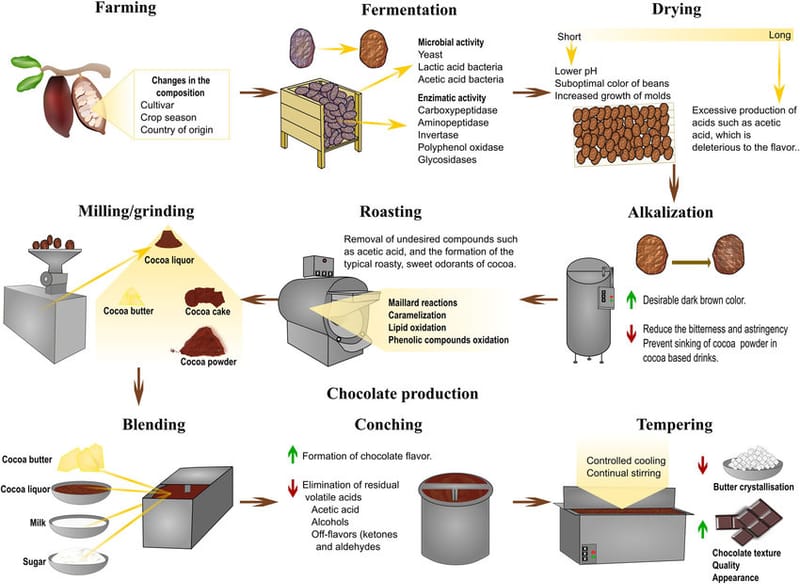Sustainable Water Management Practices and Methods in Chocolate Manufacturing
In the chocolate manufacturing industry, water is an essential resource used in various stages of production, from ingredient mixing to cleaning equipment. As the industry faces increasing environmental and regulatory pressures, adopting sustainable water management practices is crucial. This blog explores effective water management strategies in chocolate manufacturing and how Spans Envirotech can assist in implementing these practices.

The Role of Water in Chocolate Manufacturing
Water plays a multifaceted role in the intricate process of chocolate manufacturing. Let's delve deeper into its various functions:
1. Ingredient Mixing:
Water serves as a crucial medium for blending and refining chocolate ingredients. From cocoa solids to sweeteners and emulsifiers, water facilitates the uniform dispersion and integration of these components, ensuring the desired taste, texture, and consistency of the final product. The precise control of water content is essential here, as it directly impacts the viscosity and flow properties of the chocolate mixture.
2. Cooling:
In the heat-intensive stages of chocolate production, such as refining and conching, maintaining optimal temperatures is paramount. Water-based cooling systems play a pivotal role in dissipating excess heat generated during these processes, preventing overheating and preserving the integrity of the chocolate mass. By regulating temperature fluctuations, water ensures that the chocolate undergoes proper crystallization, resulting in smooth texture and superior mouthfeel.
3. Cleaning:
The sanitation and hygiene standards in chocolate manufacturing facilities are uncompromising. Large volumes of water are employed for thorough cleaning and sterilization of equipment, surfaces, and utensils throughout the production area. Water-based cleaning agents help remove residual cocoa butter, sugar, and other contaminants, minimizing the risk of cross-contamination and ensuring product safety. Effective water management in cleaning operations not only upholds hygiene protocols but also extends the lifespan of equipment and reduces maintenance costs.
By understanding the diverse roles of water in chocolate manufacturing, manufacturers can optimize its usage, minimize waste, and enhance overall operational efficiency. From ingredient preparation to product packaging, every stage of the process benefits from strategic water management practices, ultimately contributing to the production of high-quality chocolates while mitigating environmental impact.
Challenges in Water Management for Chocolate Manufacturers
The production of chocolate presents chocolate manufacturers with a myriad of water-related challenges that require careful management and mitigation strategies:
1. High Water Consumption:
Chocolate manufacturing is inherently water-intensive, with significant water consumption observed across various production stages. From ingredient mixing and refining to equipment cleaning and cooling, water serves as a fundamental resource throughout the entire manufacturing process. Managing and optimising water usage becomes imperative to minimise resource depletion, operational costs, and environmental impact.
2. Generation of Wastewater:
As chocolate production advances, it produces significant amounts of wastewater containing organic remnants, fats, sugars, and cleaning substances. It's crucial to appropriately manage this wastewater to meet environmental standards, avoid water pollution, and protect public health. Employing innovative wastewater treatment methods and maintaining strict standards for discharged water quality are vital to responsibly release or recycle treated water. This approach completes the production cycle and preserves water resources.
3. Preventing Water Contamination:
In chocolate production, preserving water quality is crucial to minimize the potential for contamination and maintain the integrity of the final product. Any lapse in water quality, be it from microbial pathogens, chemical pollutants, or particulate materials, can negatively impact the taste, texture, and safety of the chocolate. Therefore, thorough monitoring, filtration, and purification procedures are imperative to shield against waterborne impurities and uphold compliance with rigorous quality benchmarks.
4. Ensuring Adherence to Environmental Standards:
Chocolate producers must rigorously comply with environmental regulations governing water usage and wastewater treatment. This involves implementing robust water management practices, meeting specified criteria for wastewater quality, and accurately documenting compliance efforts. Non-compliance could lead to legal consequences, financial penalties, damage to reputation, and disruptions in operations. Hence, it's crucial for chocolate manufacturers to stay abreast of evolving regulatory requirements and actively embrace sustainable approaches to reduce their environmental impact and ensure the long-term viability of their businesses.
By addressing these challenges proactively and implementing innovative water management solutions, chocolate manufacturers can enhance operational efficiency, reduce environmental impact, and uphold their commitment to sustainability and corporate responsibility. Effective water management not only mitigates risks but also fosters resilience and competitiveness in an increasingly resource-constrained world.

Sustainable Water Management Practices
To tackle these challenges, chocolate manufacturers can adopt the following sustainable water management strategies:
1. Water Recycling and Reuse:
Incorporating water recycling systems can significantly cut down on water consumption. Treated water can be repurposed for non-critical tasks such as cooling and cleaning, thereby lessening the reliance on fresh water.
2. Efficient Water Usage:
Implementing techniques like closed-loop systems and high-efficiency nozzles can minimize water wastage. These systems recirculate water within the production process, ensuring maximum utilization while minimizing waste.
3. Wastewater Treatment:
Utilizing advanced wastewater treatment technologies, such as membrane bioreactors and reverse osmosis, can effectively treat wastewater to a high standard, rendering it suitable for reuse or safe discharge.
4. Rainwater Harvesting:
By collecting and utilizing rainwater, chocolate manufacturers can supplement their water supply, especially for non-potable uses like cleaning and landscaping. This practice helps reduce dependence on municipal water sources.
5. Water Quality Monitoring:
Regular monitoring of water quality ensures that the water used in production meets all necessary standards, thus preventing contamination and safeguarding the integrity of the final product.

Benefits of Sustainable Water Management
The adoption of sustainable water management practices offers numerous advantages to chocolate manufacturers across economic, environmental, and operational realms:
1. Cost Savings:
Implementing sustainable water management initiatives, like reducing water consumption and deploying efficient water recycling systems, can result in substantial cost savings. By optimizing water usage and minimizing wastewater generation, expenses related to water procurement, treatment, and disposal are reduced. Furthermore, decreased energy costs associated with water pumping, heating, and treatment contribute to enhanced operational efficiency and profitability.
2. Regulatory Compliance:
Adhering to environmental regulations governing water use and wastewater discharge is essential for chocolate manufacturers to avoid fines, penalties, and legal liabilities. Sustainable water management practices ensure compliance with regulatory requirements, including effluent quality standards and discharge limits. By investing in cutting-edge wastewater treatment technologies and embracing best practices in water management, manufacturers can uphold regulatory compliance and fulfill their social and environmental obligations.
3. Environmental Impact:
Embracing sustainable water management practices enables chocolate manufacturers to minimize their environmental impact and mitigate negative effects on natural ecosystems. By reducing water consumption, conserving resources, and implementing efficient wastewater treatment solutions, the industry can diminish its water footprint and alleviate pressure on freshwater sources. Additionally, sustainable water management contributes to corporate social responsibility objectives by demonstrating a commitment to environmental stewardship and sustainable development.
4. Product Quality:
Maintaining high water quality is crucial for preserving the integrity, safety, and sensory characteristics of chocolate products. Sustainable water management practices, such as comprehensive water quality monitoring and advanced treatment technologies, safeguard against waterborne contaminants and microbial pathogens. By consistently delivering clean, safe, and high-quality water throughout the production process, chocolate manufacturers can uphold product standards, bolster consumer trust, and safeguard brand reputation.